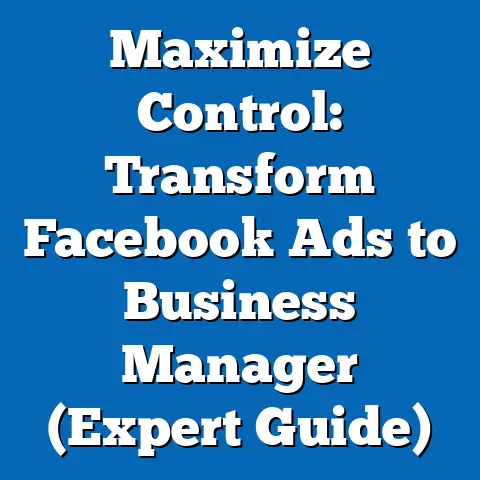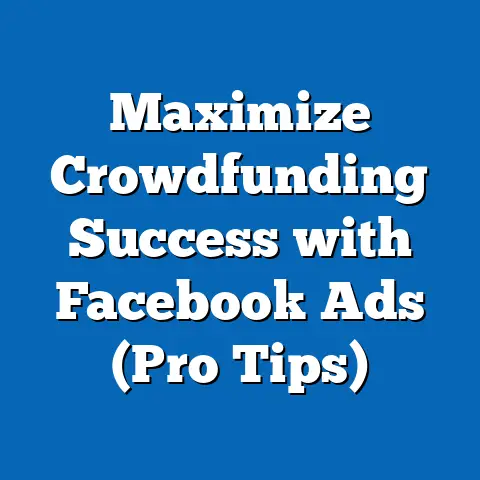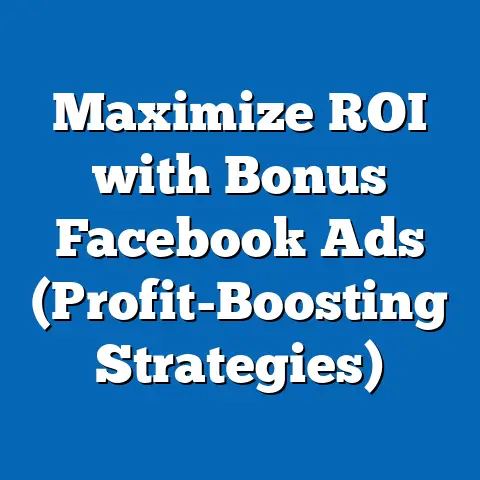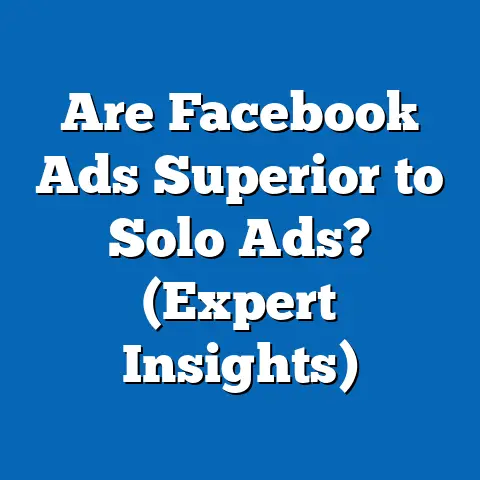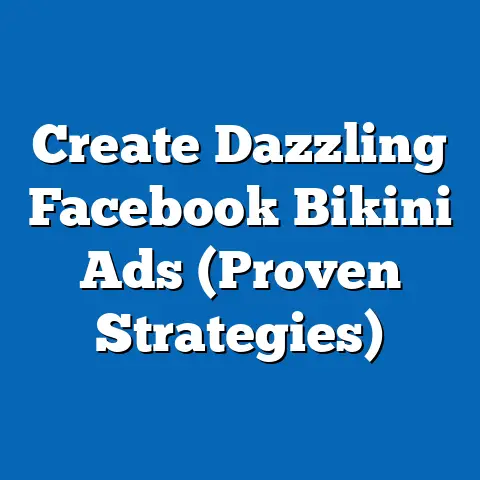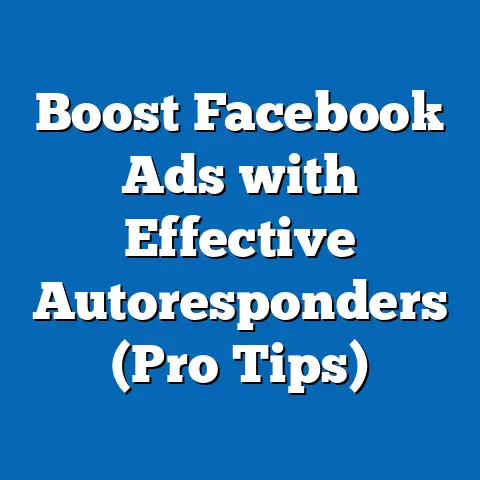Boost Engagement with In-App Facebook Ads (Actionable Tips)
The digital world is a battlefield. Every day, brands are locked in a fierce struggle for attention, vying for a precious few seconds of a user’s time in a relentless stream of content. It’s a noisy, crowded marketplace, and standing out from the crowd is tougher than ever. Think of it like this: you’re trying to whisper a secret in the middle of a rock concert. It’s not impossible, but you need the right strategy, the right tools, and a whole lot of precision. That’s where in-app Facebook ads come in – a potent weapon in your arsenal for driving engagement and achieving real success.
I remember when I first started using Facebook ads. I was so overwhelmed! I threw money at the platform, hoping something would stick. The results? Dismal. That’s when I realized I needed to get strategic, dig deep into the platform’s capabilities, and understand how to truly connect with my audience. In-app Facebook ads became my focus, and the results were transformative.
In this guide, I’m going to take you through everything I’ve learned about in-app Facebook ads, sharing actionable tips and insights that you can use to boost your own engagement and achieve your marketing goals. Get ready to cut through the noise and make your voice heard!
1. Understanding the Power of In-App Facebook Ads
What Are In-App Facebook Ads?
In-app Facebook ads are exactly what they sound like: advertisements that appear within the Facebook mobile app. They’re designed to seamlessly integrate into the user’s experience, appearing in their news feed, stories, and even within video content. These ads can take various forms, including images, videos, carousels, and collections, allowing advertisers to showcase their products or services in visually appealing and engaging ways.
Think of the last time you were scrolling through your Facebook feed. You probably saw a few ads, right? Those are in-app ads. They’re designed to feel like a natural part of the content you’re already consuming, making them less intrusive and more likely to capture your attention.
Why In-App Ads? The Advantages
The power of in-app ads lies in their ability to reach a massive audience with unparalleled precision. Facebook boasts billions of active users worldwide, making it one of the largest and most diverse advertising platforms on the planet. This massive reach allows businesses to target specific demographics, interests, and behaviors, ensuring that their ads are seen by the people who are most likely to be interested in their products or services.
But it’s not just about reach. In-app ads also offer several key advantages over traditional advertising methods:
- Targeted Reach: As I mentioned, Facebook’s targeting capabilities are incredibly granular. You can target users based on everything from their age and location to their interests, hobbies, and even their purchasing behavior.
- High Engagement: In-app ads are designed to be engaging. They’re visually appealing, interactive, and often incorporate elements of storytelling that capture the user’s attention.
- Measurable Results: Facebook provides detailed analytics that allow you to track the performance of your ads in real-time. You can see how many people are seeing your ads, how many are clicking on them, and how many are converting into customers.
- Cost-Effective: Compared to traditional advertising methods like TV or print, in-app Facebook ads can be incredibly cost-effective. You can set your own budget and control how much you spend on your ads, making it a great option for businesses of all sizes.
The Numbers Don’t Lie: In-App Engagement Stats
To truly understand the power of in-app Facebook ads, let’s take a look at some key statistics:
- Mobile Dominance: According to Statista, mobile devices account for a significant portion of Facebook’s advertising revenue. This highlights the importance of focusing on mobile-first ad strategies.
- Engagement Rates: Studies have shown that in-app ads often have higher engagement rates compared to traditional banner ads on websites. This is because in-app ads are designed to be more visually appealing and seamlessly integrated into the user experience.
- Conversion Rates: When targeted effectively, in-app ads can drive significant conversion rates. By reaching the right audience with the right message, businesses can turn casual users into loyal customers.
Key Takeaway: In-app Facebook ads offer a powerful and cost-effective way to reach a massive audience, drive engagement, and achieve your marketing goals. They’re a must-have tool for any business looking to succeed in the digital age.
Next Step: Start exploring the different targeting options available on Facebook to identify your ideal audience.
2. Know Your Audience: The Key to Engagement
Why Audience Targeting Matters
I can’t stress this enough: knowing your audience is the absolute foundation of any successful Facebook ad campaign. You could have the most visually stunning ad in the world, with the most compelling copy ever written, but if it’s shown to the wrong people, it’s going to fall flat. It’s like trying to sell snow to Eskimos – it’s just not going to work.
Audience targeting allows you to laser-focus your ads on the people who are most likely to be interested in your products or services. This not only increases your engagement rates but also improves your conversion rates and ultimately drives more revenue for your business.
Using Facebook’s Audience Insights Tool
Facebook’s Audience Insights tool is your secret weapon for understanding your target demographics. This powerful tool provides a wealth of information about the people who are interested in your brand, including their age, gender, location, interests, behaviors, and even their purchasing habits.
Here’s how to use Audience Insights:
- Access Audience Insights: Go to Facebook Ads Manager and click on “Audience Insights” in the menu.
- Choose Your Audience: You can choose to analyze everyone on Facebook or a custom audience that you’ve already created.
- Explore Demographics: Dive into the demographics data to see the age, gender, location, education level, and relationship status of your audience.
- Uncover Interests: Explore the “Interests” tab to see the pages and topics that your audience is interested in. This can give you valuable insights into their hobbies, passions, and lifestyle.
- Analyze Behaviors: The “Behaviors” tab provides information about your audience’s purchasing behavior, device usage, and other online activities.
I remember using Audience Insights for a campaign promoting a new line of organic baby food. I initially assumed my target audience was simply “parents.” But after digging into the data, I discovered that my ideal customers were actually millennial mothers who were passionate about healthy eating and eco-friendly products. This insight allowed me to refine my targeting and create ads that resonated deeply with my target audience, resulting in a significant increase in sales.
Creating Audience Personas
Once you’ve gathered data from Audience Insights, it’s time to create audience personas. An audience persona is a fictional representation of your ideal customer, based on the data you’ve collected.
Here’s how to create effective audience personas:
- Give Your Persona a Name: This helps to humanize your persona and make them feel more real.
- Describe Their Demographics: Include their age, gender, location, education level, and occupation.
- Outline Their Interests and Hobbies: What are they passionate about? What do they do in their free time?
- Identify Their Pain Points: What are their biggest challenges and frustrations?
- Define Their Goals: What are they trying to achieve?
By creating detailed audience personas, you can better understand your target audience and create ads that speak directly to their needs and desires.
Key Takeaway: Understanding your audience is crucial for creating effective Facebook ad campaigns. Use Facebook’s Audience Insights tool to gather data and create audience personas that resonate with your brand message.
Next Step: Spend time exploring Facebook’s Audience Insights tool and start creating detailed audience personas for your business.
3. Crafting Compelling Ad Creatives
The Power of Visuals
In the fast-paced world of social media, visuals are king. People are constantly bombarded with content, and you only have a few seconds to capture their attention. That’s why it’s essential to create visually stunning ad creatives that stand out from the crowd.
Here are some tips for designing eye-catching graphics:
- Use High-Quality Images: Always use high-resolution images that are clear, crisp, and visually appealing.
- Choose Relevant Images: Make sure your images are relevant to your product or service and resonate with your target audience.
- Use Colors Strategically: Colors can evoke emotions and influence purchasing decisions. Choose colors that align with your brand and appeal to your target audience.
- Keep it Simple: Don’t overcrowd your images with too much text or graphics. Keep it clean, simple, and easy to understand.
I once worked with a client who was struggling to get results from their Facebook ads. Their images were blurry, outdated, and didn’t accurately represent their brand. After redesigning their ad creatives with high-quality images and a consistent color scheme, their engagement rates skyrocketed.
Writing Persuasive Ad Copy
While visuals are important, the copy that accompanies your ad is equally crucial. Your ad copy should be clear, concise, and persuasive, highlighting the benefits of your product or service and compelling users to take action.
Here are some tips for writing persuasive ad copy:
- Focus on Benefits, Not Features: Instead of simply listing the features of your product or service, focus on the benefits that it provides to the customer.
- Use Strong Action Verbs: Use verbs like “Discover,” “Learn,” “Get,” and “Transform” to create a sense of urgency and encourage users to click on your ad.
- Keep it Short and Sweet: People have short attention spans, so keep your ad copy concise and to the point.
- Speak to Your Audience’s Needs: Address their pain points and show them how your product or service can solve their problems.
The Call-to-Action (CTA): Guiding the User
Your call-to-action (CTA) is the final piece of the puzzle. It tells the user exactly what you want them to do next. Whether it’s “Shop Now,” “Learn More,” “Sign Up,” or “Contact Us,” your CTA should be clear, concise, and compelling.
Here are some tips for creating effective CTAs:
- Use Action-Oriented Language: Use verbs that encourage users to take action, such as “Shop,” “Learn,” “Sign Up,” or “Contact.”
- Make it Prominent: Your CTA should be visually distinct and easy to find.
- Create a Sense of Urgency: Use words like “Now” or “Today” to create a sense of urgency and encourage users to take action immediately.
A/B Testing Your Creatives
A/B testing is the process of comparing two versions of your ad creatives to see which one performs better. This is a crucial step in optimizing your ad campaigns and ensuring that you’re getting the best possible results.
Here’s how to A/B test your creatives:
- Create Two Versions of Your Ad: Change one element of your ad, such as the image, the copy, or the CTA.
- Run Both Ads Simultaneously: Run both ads to the same audience for the same amount of time.
- Track Your Results: Use Facebook Ads Manager to track the performance of each ad, paying attention to metrics like click-through rate (CTR), conversion rate, and cost per acquisition (CPA).
- Analyze Your Data: Once you’ve gathered enough data, analyze your results to see which ad performed better.
- Implement Your Findings: Use your findings to optimize your ad campaigns and improve your results.
Key Takeaway: Compelling ad creatives are essential for capturing attention and driving engagement. Use high-quality visuals, persuasive ad copy, and clear CTAs to create ads that resonate with your target audience. Don’t forget to A/B test your creatives to optimize your results.
Next Step: Start experimenting with different ad creatives and A/B testing strategies to see what works best for your business.
4. Utilizing Facebook’s Ad Formats for Maximum Impact
A World of Options: Exploring Facebook’s Ad Formats
Facebook offers a variety of ad formats to choose from, each with its own strengths and weaknesses. Understanding the different formats and how to use them effectively is crucial for maximizing your engagement and achieving your marketing goals.
Here are some of the most popular ad formats:
- Image Ads: Image ads are the simplest and most common type of ad. They consist of a single image, ad copy, and a CTA. Image ads are great for showcasing your products or services in a visually appealing way.
- Video Ads: Video ads are a more engaging format that allows you to tell a story and connect with your audience on a deeper level. Video ads are great for demonstrating how your product or service works, sharing customer testimonials, or simply building brand awareness.
- Carousel Ads: Carousel ads allow you to showcase multiple images or videos in a single ad. This format is great for highlighting different features of your product or service, telling a story, or showcasing a variety of products.
- Collection Ads: Collection ads are designed for e-commerce businesses. They allow you to showcase a collection of products in a visually appealing way, making it easy for users to browse and purchase your products.
- Stories Ads: Stories ads are full-screen, vertical ads that appear in Facebook Stories. This format is great for capturing attention and reaching a younger audience.
Choosing the Right Format for Your Campaign
The best ad format for your campaign will depend on your specific goals and target audience.
Here are some general guidelines:
- Brand Awareness: For building brand awareness, video ads and stories ads are often the most effective.
- Product Showcase: For showcasing your products or services, image ads, carousel ads, and collection ads are great options.
- Driving Traffic: For driving traffic to your website, image ads and video ads with a clear CTA are effective.
- Lead Generation: For generating leads, lead ads are a great option.
I remember helping a local restaurant promote their new menu. We initially used image ads, but the results were underwhelming. After switching to video ads that showcased the delicious food and the lively atmosphere of the restaurant, their engagement rates and reservations skyrocketed.
Actionable Tips for Each Format
- Image Ads: Use high-quality images that are visually appealing and relevant to your product or service. Keep your ad copy concise and to the point.
- Video Ads: Create engaging videos that tell a story and capture the user’s attention. Use captions to make your videos accessible to everyone.
- Carousel Ads: Use compelling visuals and concise descriptions for each card in your carousel. Tell a story or highlight different features of your product or service.
- Collection Ads: Use high-quality images and videos to showcase your products in an appealing way. Make it easy for users to browse and purchase your products.
- Stories Ads: Use full-screen, vertical videos or images that are visually engaging and capture the user’s attention. Use interactive elements like polls and quizzes to encourage engagement.
Key Takeaway: Facebook offers a variety of ad formats to choose from, each with its own strengths and weaknesses. Choose the right format based on your campaign goals and target audience.
Next Step: Experiment with different ad formats to see which ones perform best for your business.
5. Timing is Everything: Scheduling Your Ads
The Importance of Ad Scheduling
Timing is everything, especially when it comes to Facebook ads. Showing your ads at the right time can significantly impact your engagement rates and overall campaign performance. Ad scheduling allows you to control when your ads are shown to your target audience, ensuring that they’re seen when they’re most likely to be active and engaged.
Think about it: if your target audience is working professionals, showing your ads during the workday might not be the most effective strategy. They’re likely busy with work and less likely to be browsing Facebook. However, showing your ads during their lunch break or in the evening might be a better approach.
Understanding Peak Times for User Activity
To effectively schedule your ads, you need to understand when your target audience is most active on Facebook. This can vary depending on your target audience, their location, and their lifestyle.
Here are some general guidelines:
- Weekdays: User activity tends to be higher during the weekdays, especially during lunch breaks and in the evenings after work.
- Weekends: User activity is generally higher on the weekends, especially on Saturday and Sunday afternoons.
- Time Zones: Consider the time zones of your target audience. If you’re targeting users in different time zones, you’ll need to adjust your ad schedule accordingly.
Practical Tips for Testing and Optimizing
- Use Facebook’s Ad Scheduling Feature: Facebook allows you to schedule your ads to run at specific times of day and days of the week.
- Analyze Your Data: Use Facebook Ads Manager to track the performance of your ads at different times of day and days of the week.
- Experiment and Optimize: Experiment with different ad schedules to see what works best for your business.
I once worked with a client who was running ads 24/7. After analyzing their data, we discovered that their engagement rates were significantly higher during the evenings and on the weekends. By adjusting their ad schedule to focus on these peak times, we were able to significantly improve their campaign performance.
Key Takeaway: Timing is crucial for maximizing your engagement. Schedule your ads to run when your target audience is most active on Facebook. Analyze your data and experiment with different ad schedules to optimize your results.
Next Step: Start analyzing your ad performance data to identify peak times for user activity and adjust your ad schedule accordingly.
6. Leveraging Retargeting Strategies
What is Retargeting and Why Does It Matter?
Retargeting is the practice of showing ads to people who have already interacted with your brand in some way. This could include visiting your website, viewing a product page, adding an item to their cart, or even watching a video ad.
Retargeting is incredibly effective because it allows you to re-engage with people who have already shown an interest in your products or services. They’re already familiar with your brand, so they’re more likely to be receptive to your ads.
Setting Up Retargeting Campaigns on Facebook
Here’s a step-by-step guide on setting up retargeting campaigns on Facebook:
- Install the Facebook Pixel: The Facebook Pixel is a small piece of code that you install on your website. It allows you to track the actions that people take on your website, such as visiting a page, adding an item to their cart, or making a purchase.
- Create Custom Audiences: Use the Facebook Pixel data to create custom audiences of people who have taken specific actions on your website. For example, you can create an audience of people who have visited your website in the past 30 days, or an audience of people who have added an item to their cart but haven’t completed their purchase.
- Create Retargeting Ads: Create ads that are specifically targeted to your custom audiences. For example, you can show ads to people who have visited your website in the past 30 days, reminding them of your brand and encouraging them to come back and make a purchase. You can also show ads to people who have added an item to their cart but haven’t completed their purchase, offering them a discount or free shipping to encourage them to complete their purchase.
Case Studies: Retargeting Success
I’ve seen firsthand the power of retargeting. I worked with an e-commerce client who was struggling with high cart abandonment rates. By implementing a retargeting campaign that showed ads to people who had added items to their cart but hadn’t completed their purchase, we were able to significantly reduce their cart abandonment rates and increase their sales.
Key Takeaway: Retargeting is a powerful strategy for re-engaging with people who have already shown an interest in your brand. Set up retargeting campaigns on Facebook to increase your engagement, drive conversions, and boost your sales.
Next Step: Install the Facebook Pixel on your website and start creating custom audiences for your retargeting campaigns.
7. Engagement Through Interactive Content
Why Interactive Content Matters
In today’s digital landscape, people are constantly bombarded with information. To truly capture their attention and drive engagement, you need to offer something more than just static ads. That’s where interactive content comes in.
Interactive content, such as quizzes, polls, surveys, and contests, encourages users to actively participate with your brand. It’s a fun and engaging way to learn more about your audience, gather valuable feedback, and build stronger relationships.
Ideas for Incorporating Interactive Elements
- Quizzes: Create quizzes that test users’ knowledge of your industry or product. This can be a fun and engaging way to educate your audience and generate leads.
- Polls: Create polls that ask users for their opinions on a specific topic. This can be a great way to gather feedback and generate discussion.
- Surveys: Create surveys that ask users for their feedback on your products or services. This can be a valuable way to identify areas for improvement and build customer loyalty.
- Contests: Create contests that offer users the chance to win a prize. This can be a great way to generate excitement and build brand awareness.
Measuring the Effectiveness of Interactive Ads
To ensure that your interactive ads are effective, it’s important to track your results and analyze your data.
Here are some key metrics to monitor:
- Engagement Rate: This measures the percentage of users who interacted with your ad.
- Completion Rate: This measures the percentage of users who completed the interactive activity, such as a quiz or a survey.
- Lead Generation: This measures the number of leads generated by your interactive ad.
- Brand Awareness: This measures the increase in brand awareness as a result of your interactive ad.
Key Takeaway: Interactive content is a powerful way to capture attention, drive engagement, and build stronger relationships with your audience. Incorporate interactive elements into your Facebook ads to stand out from the crowd and achieve your marketing goals.
Next Step: Start brainstorming ideas for incorporating interactive elements into your Facebook ads.
8. Analyzing Performance Metrics
Tracking and Analyzing Ad Performance
One of the biggest advantages of Facebook advertising is the ability to track and analyze your ad performance in real-time. This allows you to see what’s working, what’s not, and make informed adjustments to your campaigns to optimize your results.
Facebook Ads Manager provides a wealth of data about your ad performance, including:
- Impressions: The number of times your ad was shown to users.
- Reach: The number of unique users who saw your ad.
- Clicks: The number of times users clicked on your ad.
- Click-Through Rate (CTR): The percentage of users who saw your ad and clicked on it.
- Conversions: The number of users who completed a desired action, such as making a purchase or signing up for a newsletter.
- Cost Per Click (CPC): The average cost you paid for each click on your ad.
- Cost Per Acquisition (CPA): The average cost you paid for each conversion.
Key Performance Indicators (KPIs) for Engagement
When it comes to measuring engagement, here are some key performance indicators (KPIs) to monitor:
- Engagement Rate: This measures the percentage of users who liked, commented on, or shared your ad.
- Video Views: This measures the number of times users watched your video ad.
- Website Clicks: This measures the number of users who clicked on your ad and visited your website.
- Event Responses: This measures the number of users who responded to your event ad.
Interpreting Data and Making Adjustments
Once you’ve gathered data about your ad performance, it’s important to interpret it and make informed adjustments to your campaigns.
For example, if your CTR is low, it could indicate that your ad creative isn’t compelling enough or that you’re not targeting the right audience. If your CPA is high, it could indicate that your landing page isn’t optimized for conversions or that you’re bidding too much for your ads.
Key Takeaway: Tracking and analyzing your ad performance is crucial for optimizing your campaigns and achieving your marketing goals. Monitor key performance indicators (KPIs) for engagement and make informed adjustments to your ads based on your data.
Next Step: Spend time exploring Facebook Ads Manager and familiarizing yourself with the different metrics and reporting options.
9. Case Studies: Success Stories of Brands Boosting Engagement
Case Study 1: A Clothing Retailer Drives Sales with Carousel Ads
The Challenge: A clothing retailer wanted to increase online sales and drive more traffic to their website.
The Solution: The retailer implemented a carousel ad campaign that showcased their latest collection of clothing. Each card in the carousel featured a high-quality image of a different item of clothing, along with a brief description and a CTA to “Shop Now.”
The Results: The carousel ad campaign resulted in a significant increase in online sales and website traffic. The retailer attributed this success to the visually appealing format of the carousel ad, which allowed them to showcase multiple products in a single ad.
Case Study 2: A Local Restaurant Generates Reservations with Video Ads
The Challenge: A local restaurant wanted to generate more reservations and build brand awareness.
The Solution: The restaurant implemented a video ad campaign that showcased the delicious food and the lively atmosphere of the restaurant. The video featured testimonials from satisfied customers and a CTA to “Book a Table.”
The Results: The video ad campaign resulted in a significant increase in reservations and brand awareness. The restaurant attributed this success to the engaging format of the video ad, which allowed them to connect with their audience on a deeper level.
Lessons Learned
- Visually Appealing Ads: Both case studies highlight the importance of creating visually appealing ads that capture attention and resonate with your target audience.
- Clear Call-to-Action: Both case studies also demonstrate the importance of including a clear call-to-action that tells users exactly what you want them to do next.
- Targeted Audience: Both case studies targeted the right audience with the right message, resulting in a significant increase in engagement and conversions.
Key Takeaway: These case studies demonstrate the power of in-app Facebook ads for driving engagement and achieving marketing goals. By creating visually appealing ads, including a clear call-to-action, and targeting the right audience, you can achieve similar results for your business.
Next Step: Analyze these case studies and identify strategies that you can apply to your own Facebook ad campaigns.
10. Conclusion: The Future of In-App Facebook Ads
The Evolving Landscape of Advertising
The world of advertising is constantly evolving, and Facebook is at the forefront of this evolution. As the platform continues to grow and adapt, in-app ads will become an even more critical tool for businesses looking to reach their target audience and achieve their marketing goals.
Why In-App Ads are Here to Stay
In-app Facebook ads are a powerful and cost-effective way to reach a massive audience, drive engagement, and achieve your marketing goals. They offer unparalleled targeting capabilities, high engagement rates, measurable results, and a variety of ad formats to choose from.
Your Next Steps
Now that you’ve learned about the power of in-app Facebook ads, it’s time to take action and start implementing these strategies in your own campaigns. Experiment with different ad formats, targeting options, and bidding strategies to see what works best for your business. Track your results, analyze your data, and make informed adjustments to your campaigns to optimize your performance.
I’ve seen firsthand the transformative power of in-app Facebook ads. With the right strategy, the right tools, and a little bit of creativity, you can cut through the noise and make your voice heard in the crowded marketplace of social media.
Key Takeaway: In-app Facebook ads are a critical tool for engagement in the digital age. Embrace these strategies, experiment with different approaches, and watch your campaigns soar.
Next Step: Start experimenting with in-app Facebook ads using the insights provided in this article and share your experiences and results with the community.
Final Call to Action:
Don’t just read about it, do it! Start experimenting with in-app Facebook ads using the insights provided in this article. Share your experiences and results, fostering a community of learning and growth around Facebook advertising. The digital world is waiting – go out there and make your mark!

